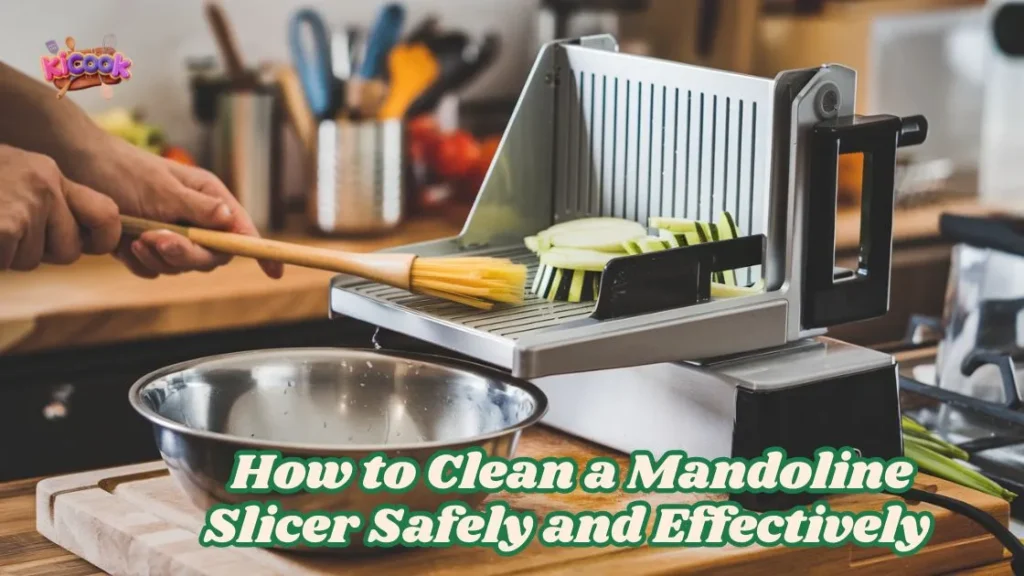To clean a mandoline slicer safely, always use a cut-resistant glove and disassemble the parts, then hand-wash them with warm, soapy water—avoid soaking to protect the blade’s sharpness.
Have you ever wondered how to clean a mandoline slicer? It’s not just about keeping it shiny—it’s about safety too. Those sharp blades can harbor food particles, leading to bacteria buildup. Plus, a clean slicer works much better. Trust me, taking a few minutes to clean it properly is totally worth it!
Important Facts
- Take apart your mandoline slicer before washing. This helps and is safer.
- Use cut-proof gloves when touching the blades. Stay safe to avoid cuts.
- Wash your slicer right after using it. This stops food from sticking and keeps it clean.
How To Clean a Mandoline Slicer? Step-by-Step Process
Disassemble the Slicer
The first step is to take your mandoline slicer apart. Trust me, this makes cleaning so much easier! Carefully remove all detachable parts, like the blade inserts and food holder. Always handle the blades by their plastic edges—those sharp edges can be dangerous. If you’re unsure how to disassemble it, check the user manual. Most manufacturers include clear instructions for this step.
Rinse with Warm Water
Once disassembled, rinse each part under warm running water. This helps wash away loose food particles. Don’t skip this step—it’s quick and prevents food from drying and sticking to the slicer.
Use a Brush or Sponge to Clean the Blades
Now, grab a soft brush or sponge to clean the blades. Avoid using your hands directly on the sharp edges. A brush works wonders for getting into those tiny grooves where food loves to hide. If you don’t have a brush, a sponge with a handle is a good alternative.
Soak in a Gentle Cleanser
For stubborn residue, soak the parts in a basin of warm water mixed with a gentle dish soap. Let them sit for about 10 minutes. This loosens any stuck-on food and makes scrubbing easier.
Scrub and Rinse Thoroughly
After soaking, scrub each part again to remove any remaining debris. Rinse everything thoroughly under warm water to wash away soap and loosened particles. You don’t want any soap residue left behind.
Dry All Parts Completely
Drying is just as important as washing. Use a clean towel to dry each part thoroughly. This prevents rust from forming on the blades and keeps your slicer in top shape.
Store the Slicer Safely
Finally, reassemble your mandoline slicer and store it in a safe place. Make sure the blades are locked or covered to avoid accidental cuts. A sturdy, dry cabinet is a great spot to keep it.
Pro Tip: Always store your slicer out of reach of children. Those sharp blades are no joke!
Tips and Precautions for Cleaning a Mandoline Slicer

Wear Cut-Resistant Gloves for Safety
Let’s be honest—those mandoline slicer blades are no joke. I always wear cut-resistant gloves when cleaning mine. It’s a simple step that can save you from painful accidents. If you don’t have gloves, consider using a thick dishcloth to handle the blades. Trust me, it’s better to be safe than sorry.
Check for Dishwasher Compatibility
Before tossing your slicer into the dishwasher, check the user manual. Some mandoline slicers are dishwasher-safe, but others aren’t. I’ve learned the hard way that hot water and harsh detergents can damage certain parts. If your slicer is dishwasher-friendly, place the blades in the top rack to avoid dulling them.
Avoid Harsh Chemicals or Abrasive Tools
When cleaning your slicer, stick to mild dish soap and soft brushes. Harsh chemicals or abrasive scrubbers can scratch the surface or ruin the blades. I once used a steel wool pad, and let’s just say my slicer didn’t appreciate it. A gentle approach works best.
Inspect the Slicer for Damage Before and After Cleaning

I always take a moment to inspect my slicer before and after cleaning. Look for cracks, dull blades, or loose parts. Catching these issues early can prevent bigger problems later. Plus, it ensures your slicer stays in top-notch condition.
Quick Tip: Regular maintenance and proper cleaning go hand in hand. Following these precautions makes the process of how to clean a mandoline slicer? much easier and safer.
Regular cleaning of your mandoline slicer is a game-changer. It keeps your kitchen safe and your slicer working like new. I’ve noticed that hand washing preserves blade sharpness and prevents food contamination. Plus, cleaning right after use makes the process so much easier. Follow these steps, and you’re all set!
Reminder: A clean slicer lasts longer and performs better. Don’t skip this step!
FAQ
How often should I clean my mandoline slicer?
I clean mine after every use. It prevents food buildup and keeps the slicer hygienic. Trust me, it’s easier than scrubbing dried-on residue later!
Can I clean the blades without gloves?
I wouldn’t recommend it. Those blades are razor-sharp. Cut-resistant gloves are a lifesaver—literally. If you don’t have gloves, use a thick dishcloth for safety.
What should I do if food gets stuck in the grooves?
Use a soft brush to gently scrub the grooves. For stubborn bits, soak the part in warm soapy water for a few minutes. It works like magic! ✨
Pro Tip: Always clean your slicer immediately after use. It makes the process quicker and safer.

